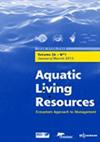Observations on feeding habits of the common dolphinfish, Coryphaena hippurus (Linnaeus 1758) from the western Bay of Bengal
IF 1.9
4区 农林科学
Q3 FISHERIES
引用次数: 0
Abstract
Coryphaena hippurus is a large pelagic species and constitutes an important by-catch in drift gillnet, trolling and long-line fishing gears operated along the Bay of Bengal, northeastern Indian Ocean. The present study, first from the region, is aimed at deciphering the feeding dynamics from 1150 individuals collected from 2017 to 2019. 32.17% of the fishes had empty stomachs or was with food traces, 45.57% had partially-full stomachs and 22.26% had full stomachs. The feeding intensity was inferred through stomach filling and predator-prey weight ratio, which was higher in May and lower in January, and increasing as increase in the fish size. Coryphaena hippurus is considered a piscivorous pelagic predator as pelagic teleosts contribute more than half of the prey species. Major prey species were big-eye scad (27.3%), squid (10.3%), crabs (9.3%), Indian mackerel (7.2%), Indian scad (5.9%), whitebaits (5.7%) and sardines (5.4%). Scads and crabs were abundantly preyed during summer and winter, while clupeids and engraulids in monsoon; however, no significant variations were observed in prey composition between sizes. Trophic Level was 4.22 ± 0.15 and Levins Standardized Niche Breadth Index was 0.30. Dietary niche breadth was higher during summer (0.48) and monsoon (0.33) and in fishes measuring 60.0–74.9 cm (0.51) and below 45.0 cm (0.48) indicating generalised feeding. This primary study from Bay of Bengal is the first comprehensive report on trophodynamics for the species and would contribute to its management using trophic interactions.
孟加拉湾西部常见海豚鱼(Coryphaena hippurus, Linnaeus 1758)的食性观察
棘鱼(Coryphaena hippurus)是一种大型远洋鱼类,在印度洋东北部孟加拉湾的漂刺网、拖网和长线渔具中是重要的副渔获物。本研究首先来自该地区,旨在破译2017年至2019年收集的1150只个体的摄食动态。32.17%的鱼胃空或有食物痕迹,45.57%的鱼胃半饱,22.26%的鱼胃饱。摄食强度通过填胃量和食饵重量比来推断,5月较高,1月较低,随鱼体大小的增加而增加。棘鱼被认为是一种鱼食性的远洋捕食者,因为远洋硬骨鱼占猎物种类的一半以上。主要捕食种类为大眼鱼(27.3%)、鱿鱼(10.3%)、蟹(9.3%)、印度鲭鱼(7.2%)、印度鲭鱼(5.9%)、白鱼(5.7%)和沙丁鱼(5.4%)。夏季和冬季是捕鲸和蟹的好时节,而雨季则是捕虾和蟹的好时节;然而,在不同大小的猎物组成中没有观察到显著的变化。营养水平为4.22±0.15,Levins标准化生态位宽度指数为0.30。饲料生态位宽度在夏季(0.48)和季风期(0.33)较高,在60.0-74.9 cm(0.51)和45.0 cm(0.48)以下的鱼类中显示出普遍摄食。这项在孟加拉湾进行的初步研究是关于该物种营养动力学的第一份综合报告,将有助于利用营养相互作用对其进行管理。
本文章由计算机程序翻译,如有差异,请以英文原文为准。
求助全文
约1分钟内获得全文
求助全文
来源期刊

Aquatic Living Resources
农林科学-海洋与淡水生物学
CiteScore
2.30
自引率
0.00%
发文量
10
审稿时长
>24 weeks
期刊介绍:
Aquatic Living Resources publishes original research papers, review articles and propective notes dealing with all exploited (i.e. fished or farmed) living resources in marine, brackish and freshwater environments.
Priority is given to ecosystem-based approaches to the study of fishery and aquaculture social-ecological systems, including biological, ecological, economic and social dimensions.
Research on the development of interdisciplinary methods and tools which can usefully support the design, implementation and evaluation of alternative management strategies for fisheries and/or aquaculture systems at different scales is particularly welcome by the journal. This includes the exploration of scenarios and strategies for the conservation of aquatic biodiversity and research relating to the development of integrated assessment approaches aimed at ensuring sustainable and high quality uses of aquatic living resources.
 求助内容:
求助内容: 应助结果提醒方式:
应助结果提醒方式:


